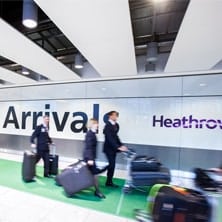
We were asked a short time ago to provide a simulation of every terminal at Heathrow with the objective to determine how many premium buggies could operate within the terminals at any given time.
For this, we had to build a simulation that modeled the floor area of the terminals, both Arrivals and Departures, by determining how many people were in the terminal at any given time, to IATA standards. Each person obviously takes up a certain amount of space, and that space determines how many Premium (and indeed, PRM) buggies can get through at any time. They go where passengers go, so there must be space for both.
For this we need to use schedules and behavioural modeling to get a true idea of where each passenger would be at any time. Looking at questions like:
- When would passengers arrive?
- What percentage of journeys would be made by PRM?
- Where are they going – checking in, eating, browsing the shops, visiting the toilet or just sitting and waiting?
All of these activities take up space and resources at different areas at different times. We also had to be aware of demographics and practicalities – which of these passengers were going to Executive Lounges, were they waiting for long haul flights or short haul flights, or were they just there to wave off and pick up?
By breaking down the terminal into small squares, we were further able to determine the routes that each individual passenger takes. Most of us visit an airport in a very structured way, for example:
Park car – Take bus to airport – Check in – Go through security – Get something to eat – Shop – Sit and wait – Hover by the boards waiting for the gate announcement – Take a last minute toilet break – Travel to the gate – Wait – Board Plane
When we know the percentage of passengers doing each activity, linked to the flight schedules of the airport, we can easily determine the space taken up in each of the Terminal’s ‘squares’ at any time of the day and from that it was very easy to determine the space left for the maximum Premium Buggies that could be used at each time of day.
This was of great benefit to the client, but also of great benefit to our services. With this Terminal Passenger Behaviour Modelling Tool, we can extend the knowledge we have of passenger behaviour in airports across to other applications and clients. For example, we could also determine the number of taxi drivers waiting in Costa to pick up Arrivals at any given time. Just think about what else we can find out!
Read our next blog to find out more about how this tool has been used across airports, with surprising results!

